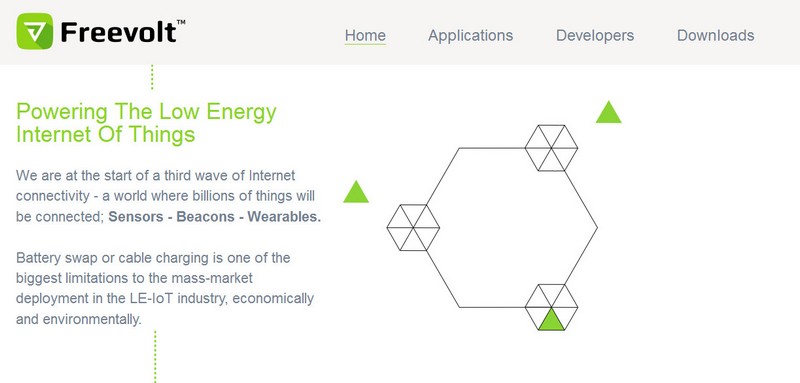Wireless Power Harvesting Tech Now Being Commercialized, Thanks to Freevolt

Image credit: Draysen Technologies, screenshot of the official Freevolt website (http://getfreevolt.com/)
Were you impressed by the ant-sized wireless power harvesting radio we featured on this blog before? Unfortunately, it is not yet available for commercial implementation. The good news, however, is that a UK finally has unveiled a similar wireless power harvesting tech and is now commercially available. This technology can convert radio frequency waves into electricity to power up low voltage devices. The product was unveiled in London last Wednesday, launched by former British science minister Lord Paul Drayson at a Royal Institution theater where electromagnetism pioneer Michael Faraday conducted lectures a century ago.
Freevolt Technology
The wireless power harvesting tech launched in London is called Freevolt. It is a patented technology (that includes the Perpetual Power and CleanSpace brands) that aims to power low energy Internet of Things (IoT) devices. Freevolt produces electricity from 2G, 3G, 4G, Wi-Fi, and digital TV signals. Drayson demonstrated (at the launch) that this technology really works by powering a loudspeaker using the electricity derived from the signals of the mobile phones of those present at the event.
Freevolt is owned and developed by Drayson Technologies, Ltd., a development stage electronics company based in London, with operations in Silicon Valley focused on wireless energy transfer tech.
Energy Harvesting from Anywhere
Designed to be small, low cost, and usable in any orientation. The Freevolt technology features a multi-band antenna and rectifier set that transforms alternating current to direct current. This antenna-rectifier combination, however, is capable of doing more than just converting AC to DC. It can also harness energy from electromagnetic wave frequencies. In the words of the technology’s developers, it is “capable of absorbing energy from multiple radio frequency bands.”
With its size, it can be implemented within small IoT and wearable devices. It can work in users’ pockets, on the wrist, mounted on a wall or on top of a desk, or as parts of smart sensors and kiosks. It is a highly convenient solution for IoT and wearable power supply issues, obviously, as it removes the need for frequent charging or the need to swap batteries. Additionally, Drayson Technologies claims that this tech can help enhance battery life and even improve device aesthetics as it makes it easy for devices to be safely and hermetically sealed.

Image credit: Draysen Technologies, screenshot of the official Freevolt website (http://getfreevolt.com/)
Scalable System
The amount of electricity generated by the Freevolt tech depends on a number of factors. One of the most important among these factors is the size of the antenna. Theoretically, a credit card sized Freevolt antenna is capable of producing up to 100 μW in a high energy environment like an office or a home with many wireless devices in use. If more power is required, bigger antennas or an array of several antennas may be used. This technology can be scaled up to address different levels of low power needs.
To emphasize, regardless of its scalability, this technology is only intended for devices that require low levels of power. After all, the amount of electricity that can be produced by harvesting wireless signals is not that big to power typical household appliances. Even if a humongously scaled up Freevolt system is created, the amount of wireless signals at a given location is only limited and overharvesting these signals is not a good idea.
Overcoming the Efficiency Problem
Generating power from wireless signals is not a new idea. Developments centered on this idea have been already been started many years ago. However, the problem of being able to produce enough electricity from fluctuating wireless signals had been difficult because of inefficiency. Drayson Technologies claims that it has already overcome the problem of wireless energy harvesting efficiency with the use of a patented rectifier design capable of capturing the maximum amount of RF energy as part of the rectifying process.
Will It Affect Wireless Signals?
Freevolt is not designed to be disruptive to the main purpose of having wireless signals around. However, it can be scaled up to levels that may end up disrupting wireless transmissions. So, yes, it can affect wireless signals when excessively scaled up or not used as intended. However, when properly implemented, it should only have a “knock-on” effect on wireless transmissions.
Commercial Availability
At the moment, Drayson Technologies offers the Freevolt tech as a pre-orderable development kit. This development kit will allow interested parties to develop systems that employ the Freevolt technology in powering up specific devices or products. In other words, Drayson is not offering specific products that carry the Freevolt tech except for the CleanSpace tag, a personal air quality pollution sensor. This sensor is powered by energy derived from wireless signals and is designed to work with a smartphone or tablet.

Image credit: Draysen Technologies, screenshot of the official Freevolt website (http://getfreevolt.com/)
If you are interested in this exciting power generation technology, drop by the official Freevolt website. Be reminded, however, that only the Cleanspace tag is available to individual consumers. Freevolt-based electronic products are not yet available on the market but electronic device makers can already start conceptualizing and building products that make use of Freevolt tech.